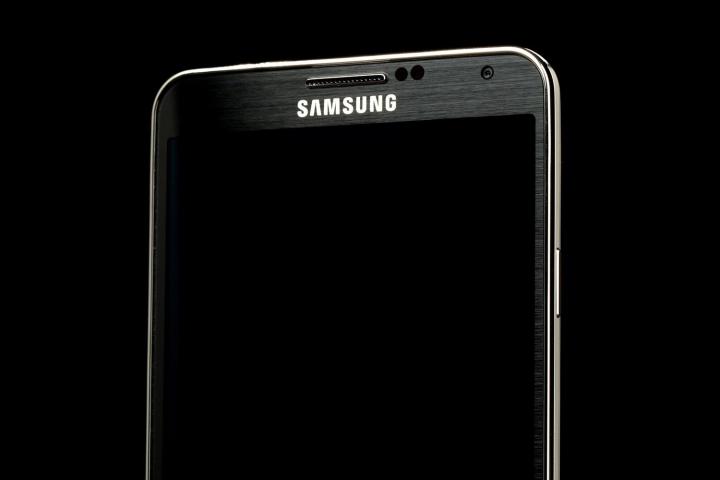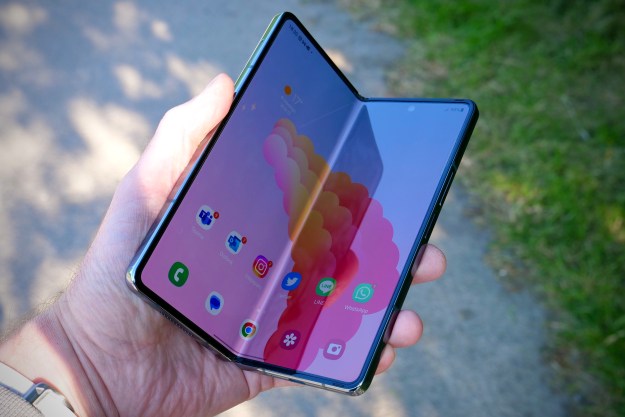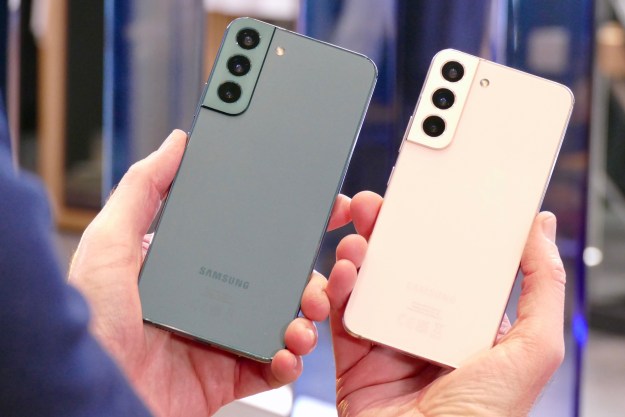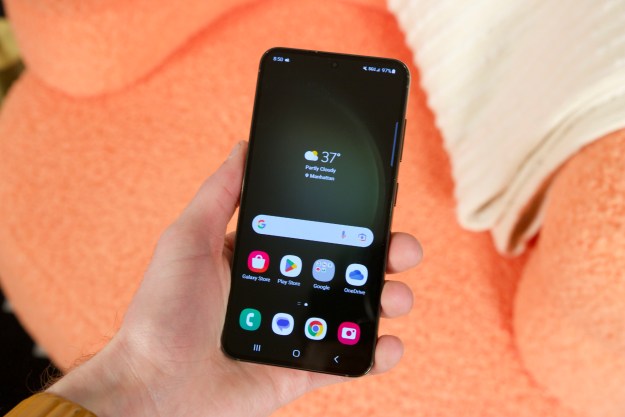
“With industry-leading specs, a great screen, and improved S Pen implementation, plus a nicer exterior, the Note 3 is a very impressive piece of hardware. But it has a mountain of features that can be overwhelming, even for Android veterans.”
- Great battery life
- Excellent screen
- Top-notch specs and performance
- More premium look and feel than previous Notes
- Runs Android 4.3, the newest version
- S Pen still doesn’t feel like a must-have feature
- Abundance of added features will be overwhelming for many
- Poor speaker placement
When Samsung first launched the original Galaxy Note in 2011, many analysts and reviewers decried the device’s 5.3-inch screen as too big for the average person’s hand, and tried to explain away “phablets” were just a phase (we did this, too).
But here we are, two years on, and Samsung claims it’s sold more than 40 million Notes worldwide. Clearly, we were wrong. If the phablet is a fad, it’s certainly been a profitable one. Other smartphone makers are riding the train, too with upcoming devices like Sony’s Xperia Z Ultra, LG’s Vu 3, the rumored HTC One Max, and more.
Make no mistake, the Note 3 isn’t just a superphone in size alone.
Is the Note 3 the best big-screen phone you can buy? Or are its kitchen-sink lit of features more confusing than useful? Follow us on an S Pen-aided journey while we find out.
A little pleather will do ya good
Rather than the slippery plastic exterior found of many of Samsung’s recent Galaxy phones (as well as the Note 2), Samsung has gone with a faux-leather back on the Note 3. It certainly looks nicer, and makes the Note easier to hold, thanks to its textured finish. But it is still made of plastic (or polycarbonate if you prefer marketing speak), so while the Note 3 feels more like a premium product than its predecessor, the aluminum-clad HTC One and the iPhone 5S feel more premium, at least to our fingers.

We still recommend a case for the Note 3 if you want to keep your device pristine. After only a couple days, we accidentally nicked the top of ours by sticking it in a back pocket with some keys.
Still, the Note 3 feels nice in the hand, thanks to a ridged metal rim that runs around the edges of the device. The phone is only slightly smaller and slimmer than the Note 2, shaving off a millimeter or two here and there. But it doesn’t feel chunky at 8.4mm thick, and its 167-gram weight feels solid, but not heavy (it’s about 10 percent lighter than the Note 2).
And maybe it’s because we also just spent time with the Galaxy Mega and its 6.3-inch screen, but the Note 3, with its 5.7-inch panel, doesn’t feel huge in our hand. Sure, it’s big. And yes, you probably will feel goofy when you hold it to your head to make a call. But with even bigger phone/tablet devices like the 6.4-inch Sony Xperia Z Ultra and the rumored HTC One Max shipping soon, the Note 3 probably won’t be the biggest phone you’ll see in public in the coming months. So the frequency of people exclaiming “OMG, that phone is huge!” in your general direction when you use the Note 3 will lessen this year.
And while we didn’t hate the size of the Galaxy Mega, the Note 3 is a much better fit in our jeans pocket and was easier to handle – 5.7 inches may indeed be the ideal screen size for big-screen phones.
Button placement is exactly what we’d expect from a modern Samsung phone. The power button lives on the right edge, near the top and the volume rocker is in the same place on the other side. The headphone jack and Infrared blaster (for using the Note 3 as a universal TV remote) sit up top, also where we’d expect them.
A next-generation charging cable
On the bottom edge of the device, things are more interesting and problematic. For starters, the charging port here is Micro USB 3.0, which means it’s wider than on other Android phones. The good news, though, is that you can still use a standard Micro USB cable to charge the phone, so you won’t have to throw away your chargers.
If you do use the USB 3.0 cable Samsung includes with the device to plug it into a computer, you’ll get a couple benefits. USB 3.0 delivers more power than 2.0 when plugged into a USB 3.0 port, so the phone will charge faster (but still not as fast as it will when plugged into a wall). And as you might guess, USB 3.0 is faster than 2.0., so file transfers to and from the phone to a PC should also be speedier. But this speed is likely limited by the abilities of the Note 3’s internal storage, not a cable or port. With so much media being handled in the cloud these days, USB 3.0 won’t be a substantive benefit for most users.
Poor speaker placement
Also on the bottom of the Note 3 is the S Pen (which we’ll get into in detail in a bit), and the speaker. We’re happy to see Samsung moving the speaker off the back of the device. But where it sits on the Note 3 – close to the upper-right corner when you hold the phone in landscape orientation – is a problem. It’s right where your thumb or palm wants to rest when holding the device to watch a video. We tried different hand positions to avoid blocking the speaker when holding the Note 3 horizontally, but everything that felt natural or comfortable muffled the audio. And even unblocked, speaker output only sounds about as good as the Galaxy S4. HTC’s One still has, by far, the best sound we’ve heard from a

A flagship screen for a flagship phone
The Note 3’s screen leaves no room for complaints – or at least very little. At 5.7 inches, it’s a bit bigger than the 5.5-incher on the Note 2. Its 1080p resolution is what we’d expect from a modern high-end
Viewing angles on the Note 3 are great, and because it’s an AMOLED panel, colors are vivid, blacks are deep, and the screen is bright enough that the only time you’ll ever want to crank it up to maximum is when you’re directly under a sunbeam. But while AMOLED has its benefits, it also tends to oversaturate colors, and this is no exception. But, those ultra-bright hues tend to draw the eyes, even if they aren’t entirely accurate, which is likely why Samsung chose a colorful abstract oil painting to as the Note 3’s default unlock screen.
Don’t expect a class-leading camera
On paper, the Note 3’s camera sounds great. Samsung stepped up to a 13-megapixel sensor from 8 megapixels in the previous model, and went with a 2-megapixel shooter on the front for video calls and selfies.
But megapixels aren’t everything. While the phone’s innards make autofocus and image processing super-quick, the photos we took with the Note 3 were pretty good but rarely great. In daylight, outdoor shots looked good, but when the sky became a bit more overcast, our shots were darker than we’d like. And photos of colorful flowers appeared oversaturated (not just when viewed on the phone’s screen). Low-light performance also wasn’t good without the flash. If you like to take photos in dimly lit bars and restaurants, HTC’s One or Nokia’s Lumia line will deliver far-better photos.
The Note 3 does shoot video at
Cluttered Interface, but a fantastic pen
The Galaxy S4 took Google’s default, stock
It’s impossible to detail all the Note 3’s features without turning this review into a book, so we’re going to focus mostly on S Pen, since that feature is the Note’s major differentiator. If you’d like details on some of the Note’s other software features, you can check our review of the Galaxy S4, since most of what’s there carries over to the newer device.
The S Pen fits securely in its slot on the bottom of the phone, but after some practice, pulling it out is fairly easy, thanks its ribbed metal cap. When you start to pull the pen out, the phone’s screen will switch on automatically and the Air Command menu pops up in the screen’s lower-right corner. Air Command offers icons for five different S Pen tasks, and you can activate it any time by holding the down the button on the S Pen and hovering over the Note 3’s screen.
Action Memo lets you jot down quick things like, say a phone number or address with the S Pen and, with a tap, add it to your address book, dial the number or send a text, or look up the address in Google Maps or the Web browser. This worked well for us with phone numbers and addresses. Surprisingly, the handwriting recognition works. But email addresses gave us a problem. The screen just isn’t wide enough to write out most email handles. And when we split the address onto two lines, the Note 3 had a tendency to only recognize part of the address.
Scrap booker is what it sounds like – a Pinterest-like board that lives on your phone. You can draw a circle around dynamic content on the phone, like Web pages, YouTube videos, etc., and store them in the Scrapbook app. Things like Web addresses in your snipped content will remain live when you go back to look at them. But the amount of metadata that’s saved feels like a hit-and-miss affair. For instance, we saved a restaurant we looked up in
Screen Write is also self-explanatory. It takes a screen shot and lets you jot notes on top of it. This can also be done at any time with the S Pen by holding down the button on the side of the pen and long pressing on the screen.
Pen Window lets you open a select few apps in a small window. To open it, draw a square on the screen and a box appears with icons for Calculator, Clock, YouTube, Phone, Contacts, ChatOn, Hangouts, and the Web browser. This feature is more useful on the larger-screened
If you want to have more than one app open at the same time, there is, of course, the Multi Window mode, which lets you launch multiple apps and drag the edges around to decide how much space they take up, a lot like in Windows 8. Again, though, this is a feature that feels like it would be much more useful on a larger-screen device.

Lastly, S Finder is a sort of global search for the device. You can use it to search through your handwritten notes, media, calendar, message, etc. For forgetful types, or those who working on multiple projects at once, this could be helpful. But for us, at least, the nicest feature here was the ability to scroll through everything from the past seven days (30 days is also an option). The information is laid out visually, with conversations, notes, and images showing up in a vertical feed, which is helpful on a forgetful day. We do wonder how much space this feature will eat up on the phone over time.
If you need a break from all the features, apps, icons, and widgets on the Note’s home screens, you can swipe up from the bottom and bring up Magazine UI, which borrows heavily from Flipboard (and HTC’s BlinkFeed) to give you a visually pleasing, vertical scroll of news, recent social media posts from your friends, and a collection of your recent notes and photos. Scroll vertically to browse content in a specific category, like news. Swipe left and you’ll see social media posts, swipe right to access your personal data and notes.
Using the S Pen always felt slower and more cumbersome than using the keyboard or speech-to-text.
We like the look and feel of Magazine UI a lot, and it’s more customizable than HTC’s BlinkFeed. But there still doesn’t seem to be a way to add specific sites into your feed (like Digital Trends). You can do this on Flipboard itself (which comes pre-installed on the phone). So when we signed in to our Flipboard account, we kind of expected that the News section of the Magazine UI would pull in our customized Flipboard feed. But sadly, that doesn’t seem to be the case.
So, what’s it like to actually use the S Pen to jot down notes? We know people swear by it. But for us at least, writing things down always felt slower and more cumbersome than using the keyboard or speech-to-text.
As an experiment, we tried jotting down a brief message (31 words) with the S Pen. That took us 90 seconds, and the handwriting recognition wound up with four errors. Tapping the same message out on keyboard took 45 seconds with zero errors. Swyping also took 45 seconds and had zero errors. Dictating the message into the phone took less than 15 seconds and, aside from line breaks we had to put in manually, there were no errors. We then tried writing the message again using the stylus, and wound up taking about 85 seconds, but our handwriting must have been a bit sloppier—the handwriting recognition made even more errors.
To be fair, our handwriting is pretty bad (we type for a living), and the Note got things right most of the time. But it does work best when you write one word at a time, pausing a second or so between words while it converts them into text. Otherwise, the Note will often turn multiple words into a single jumble. That, combined with the small size of the screen (compared to an actual notebook), means that writing with the S Pen is best for very short messages.
As you may have guessed now that you’re 2,700 words into this review, we don’t do short messages that well. So we don’t think the S Pen is a killer feature for us in this form factor. On something like the Note 8.1, we’d probably use it more often.
Dethroning the G2 as the most powerful phone
All the Note’s fancy features would be useless or, at the very least, frustrating if the Note 3’s internals weren’t up to the task of keeping things running smoothly. But that’s not an issue here. With its 2.3GHz quad-core processor and ample 3GB of RAM (up from 2GB in last year’s model), the Note 3 performed flawlessly nearly flawlessly, even when we had more than 10 apps running while downloading podcasts in the background. The only issue we saw was choppy playback of Hulu Plus videos at high settings. Stepping down to medium made playback smooth again, and YouTube playback was smooth at any setting.
If anything, we’d say the Note 3’s battery life is better than the Note 2.
We did our testing on a T-Mobile model, and on that “un”carrier’s 4G network, performance varied. But we were consistently able to get download speeds of between 13 and 18Mbps, while upload speeds hovered around 8-10Mbps.
Solid battery life
Battery life doesn’t disappoint, either. Samsung upped the cell’s juice slightly, from 3,100mAh in the Note 2 to 3,200mAh. But with the larger, higher-resolution screen, more
After 16 hours and 15 minutes of medium to heavy use, playing a few games, taking and uploading images to Facebook, reading a magazine on Zinio, making a couple phone calls, sending a few texts, running some benchmarks, and installing and updating several apps, all over a mix of 4G and Wi-Fi, we only managed to get the battery down to 30 percent.

In other words, our brain conked out long before the Note’s battery did. Unless you leave your screen on for literally half the day, you should easily be able to get a full day’s charge out of the Galaxy Note 3. Many will be able to go for two days without a charge.
Conclusion
For power users looking for a big-screen phone to help manage their hectic lives, the Galaxy Note 3 is a no-brainer, especially if you like the idea of using a stylus for jotting down notes. And even if you don’t use the S Pen, the device still delivers excellent battery life and a great screen in a package that looks, performs, and feels like a serious productivity device, not a toy-like colorful slab of plastic and glass (hello, iPhone 5C).
That being said, there are so many features loaded into the Note 3 that we’re pretty sure we didn’t cover half of them. For instance, if you leave the S Pen behind and walk away with the phone, a pop-up window and a sound alerts you that you’ve forgotten your stylus. Also, the Wi-Fi radio supports 802.11ac, so the phone will play nice with next-generation routers. We could go on, but we already have.
And that, really, is the Note 3’s biggest failing. It’s not a good fit for
If you don’t mind feature clutter and the device’s high price, or you just want a big-screen phone that has the fastest internals for gaming and multitasking, the Note 3 is the best phone for you. But if a big screen and good performance are mostly what you’re after, there are other big-screen options, and there will soon be more. If you can live with a lower-resolution screen (that’s still pretty great) and the absence of the S Pen, Samsung’s Galaxy Mega is a good choice. It’s not as exciting as the Note 3, but using it isn’t nearly as overwhelming, either.
Highs
- Great battery life
- Excellent screen
- Top-notch specs and performance
- More premium look and feel than previous Notes
- Runs Android 4.3, the newest version
Lows
- S Pen still doesn’t feel like a must-have feature
- Abundance of added features will be overwhelming for many
- Poor speaker placement
Editors' Recommendations
- Best Samsung Galaxy deals: S24, Buds, Watches and more
- Best Samsung deals: The Galaxy S24 Ultra is up to $750 off
- Samsung Galaxy Watch 7 Ultra: news, rumored price, release date, and more
- The best Samsung Galaxy Watch in 2024: Which one should you buy?
- The Galaxy Z Fold 6 and Flip 6 release date just leaked




















